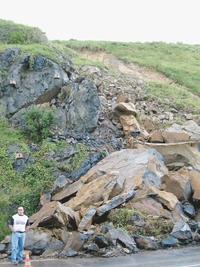Slope dynamics

Slopes are common both on the railway network and on the road. The slopes are steep slopes that have been exposed after eating a piece of mountain. As they are unstable areas, they generate numerous problems and, in the case of Euskal Herria, they are aggravated by the rugged orography, the high rainfall and the abundance of collapsed and broken sedimentary materials.
Risks and damage
In the case of rock slopes, the formation of instabilities depends on the geomechanical characteristics of the set of rocks, the conservation status of the slope itself and the conditions of water penetration.
It must also be taken into account that some slopes direct the rocks directly to the route, since the materials cut in the construction works pointed to this direction, but in others the rocky ensembles are crossed by the route, reducing the associated risk.
Corrective measures
Geotechnical studies consist of the identification, control and correction of potentially unstable elements by developing specific protocols or programs for potential risk zones. These programs would assess the benefits that would be obtained with corrective measures and solve the problems registered.
Specifically, the hydrogeological geotechnics group of the UPV/EHU has developed a program based on 10 parameters: classification of the rock (established by the group of hydrogeological geotechnics for the Basque Country), orientation of discontinuities, hydraulic conditions, ease of weathering, slope history, volume of the block/unstable mass, slope height, probability of distance from the road, visibility vs.
These parameters assess the stability of the slope and possible conditions for rock detachment. This classification distinguishes eight types of rocks, providing information about their characteristics and their behavior at work.
Finally, corrective measures are proposed for each type of rock. Among them are the use of steel bars as tensors, the coating of slope with concrete, the placement of dynamic networks of rock elevation, etc. In short, all studies aim to propose appropriate corrective measures and minimize risks.
Buletina
Bidali zure helbide elektronikoa eta jaso asteroko buletina zure sarrera-ontzian











